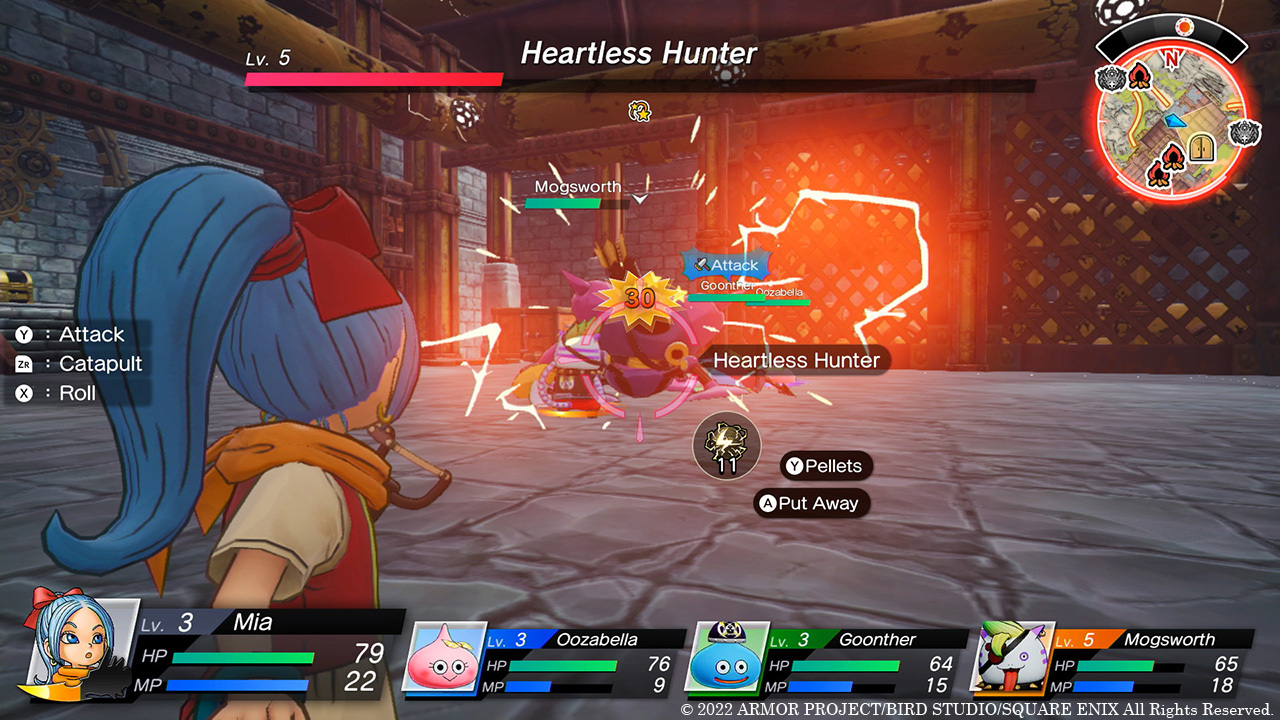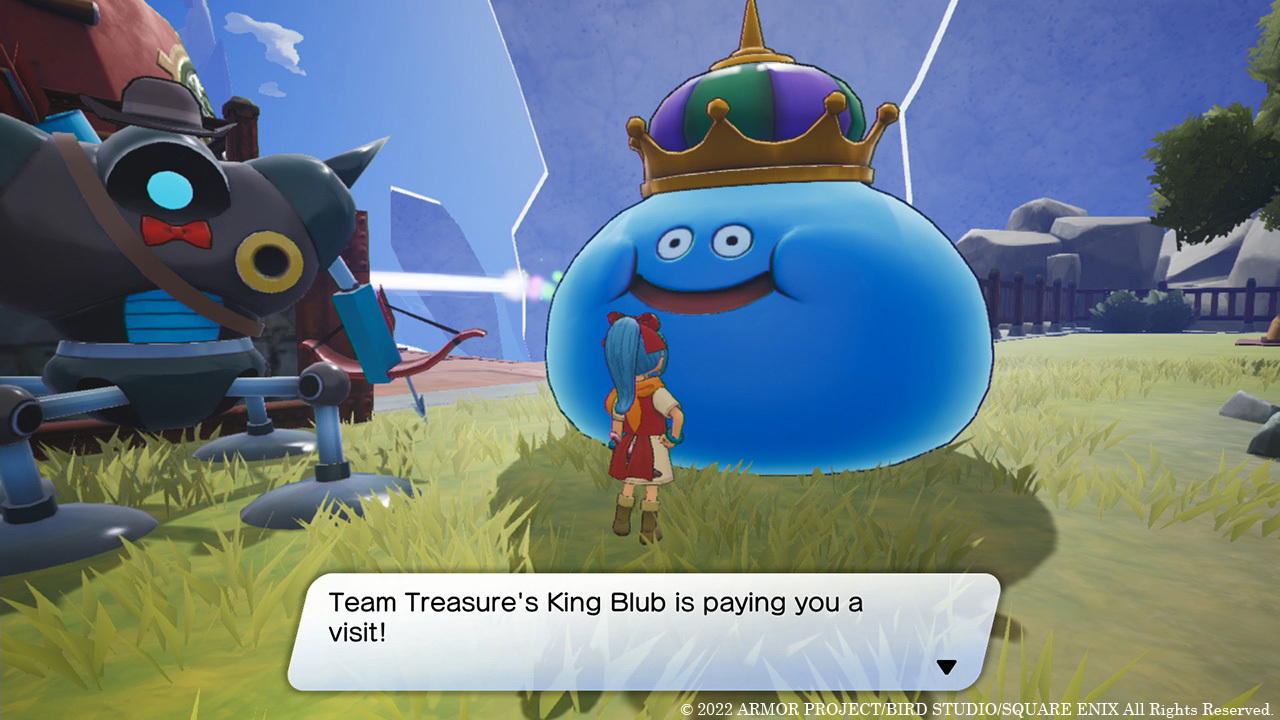Loot. Few words in gaming hold such power. The promise of sick loot is a siren song that has driven many a player to take on bold challenges and reconsider their objectives… as well as to make exceptionally poor judgments and even pry open their real-life wallets. Many games, regardless of era and platform, are fundamentally about the satisfaction of obtaining loot, but few will admit that. Dragon Quest Treasures is the rare game that states outright that accumulating a trove of legendary loot is the whole point–and, if you can endure some of its gameplay and technical foibles, you too can experience the satisfaction of having a Scrooge McDuck-like vault of gold (but not the experience of swimming in it).
Dragon Quest Treasures tells the tale of young Erik and Mia, who were first introduced in Dragon Quest XI. Dissatisfied after having been adopted by the pillaging, hard-partying Vikings, the duo decide to escape from the ship and go out on their own to become great treasure hunters. Along the way they free a duo of odd winged critters and stumble upon the Dragon Daggers, enchanted weapons that whisk them away to the realm of Draconia, where treasure hunting is a way of life. Somewhere on these floating islands lie the legendary Dragonstone artifacts, and Erik and Mia are going to get them all–along with an absurd amount of mythical relics just waiting to be dug up.

Gallery
Unlike the mainline Dragon Quest series, which is turn-based and menu-driven, Dragon Quest Treasures is an action-RPG. Playing as either Erik or Mia (who are functionally identical), you explore one of several large open-world islands, defeating enemies, completing quests, gathering materials, and–most importantly–discovering those sweet, shiny silver and gold treasure chests. The more treasure they find, the more notoriety they get–and the more their base, initially a decrepit magical railroad station, becomes remodeled into a fabulously gaudy headquarters. This also opens up more gameplay elements, as well as revealing hints about the location of the elusive Dragonstones. While you can explore the game freely at your own pace, some parts are progress-locked based on how much loot you’ve accumulated.
Draconia isn’t a tiny territory, either. The areas you can go to are surprisingly large and filled with distinct geographical features–and contain only a precious few unlockable fast-travel points in the form of railroad stations. The treasures that spawn each time you visit an area are randomized, encouraging you to both revisit well-tread territory and venture into new places. With both your restricted loot-carrying capacity and high-level enemies limiting your ability to explore, it usually takes several attempts before you manage to fully probe an entire region. The size of these areas is impressive, and the game runs at a solid 30fps most of the time, but it comes at a cost: The geometry of the environments tends to look extremely simplistic, and the textures are visibly pixelated and muddy.
Erik and Mia are at a disadvantage, as they don’t have the sixth sense for locating treasure that the native Draconians do. Fortunately, they can enlist the locals for help. As their upstart treasure-hunting gang gains steam, the monsters they encounter apply for membership and can be recruited as NPC party members. Your monster recruits are very important: They fight alongside you in combat, help you navigate the environment using special “forte” skills (like gliding, bouncing high, and burrowing underground), and–most importantly–can alert you to the presence of treasure. Erik/Mia have limited use of a compass to find an approximate location of high-level treasure, but when you’re really close to the prize, the monsters can give you “Treasure Visions” of the exact location. (Monster sight isn’t quite the same as humans’, however, so things may still look rather odd–for example, a muddy hand monster’s vision looks like it has goopy film sprayed on it, while living armor can only see through the vents of its helmet.) They can also find exact locations of mid-tier treasure as you wander around–though, since treasure-carrying capacity is limited, you may opt to skip silver chests in favor of generally higher-value gold. Further along in the game, you’ll also have to fend off rival gangs that attack mid-exploration to steal your hard-earned goods.
The gradual exploration of big, varied environments and your ever-growing vault of valuables makes for a very enjoyable gameplay loop. It’s satisfying to watch your headquarters grow and expand while your monster ranks swell with high-level recruits and your display case fills with some of the most legendary items from across the Dragon Quest series. The charm is further bolstered by the warm, inviting atmosphere that’s pervasive across the whole of the Dragon Quest franchise, including a localization that’s packed with snappy dialogue and delightfully groan-worthy puns. Dragon Quest Treasures simply feels nice to play.

Gallery
Unfortunately, one element of the game does its best to ruin the mood. Combat is easily the worst part of Dragon Quest Treasures, and it’s an unavoidable part of exploration and progression. You and your CPU-controlled monsters all take part in battles, which happen in real time on the world map. Erik and Mia are armed with their Dragon Daggers, which offer only a basic attack combo string. While they have a pool of MP, their magic is only used for healing themselves. Instead, special attacks come in the form of a long-range slingshot, which you can load ammo (in the form of pellets) into and fire. Pellets are the only way you’re able to access different forms of elemental damage, and trying to fumble your way through the pellet menu to find that one rock that will hit a foe’s weakness is a hassle. Making it worse is that you also heal and put buffs on your monsters through special pellets. Trying to aim a bunch of rocks at your constantly moving monsters mid-battle to heal them or increase their defense will make you long for a more traditional action/RPG skill system.
Your monsters act of their own volition, with you only able to issue basic “attack” and “fall back” commands, which don’t always seem to be heeded. Their AI is generally decent, though when it does fail, it becomes quite frustrating–one big flaw is the lack of a lock-on system to get everyone to target a specific problem enemy. The big issue, however, is that watching your monsters roll, smash, wobble, and spellcast makes it hit home just how limited and dull your own combat abilities are. It constantly feels like your CPU buddies are having a lot more fun than you are during fights, and that sense of weakness never quite goes away. Even with the special “Wild Side” skill that ups your speed, damage, and critical rate is nowhere near as cool and effective to use as your monsters’ special cinematic “Unleash the Dragon” attacks.
It’s a testament to how strong the other elements of Dragon Quest Treasures are that, in spite of combat frequently being unfulfilling, the game still manages to keep you eagerly coming back for more exploration and treasure-scouting. Its bright-eyed, adventurous atmosphere and rewarding core gameplay loop go a long way in carrying the game to its conclusion. It might not be the richest game out there, but for the length of its runtime, Dragon Quest Treasures does a fine job of making you feel like a bandit king.
Comments are closed, but trackbacks and pingbacks are open.